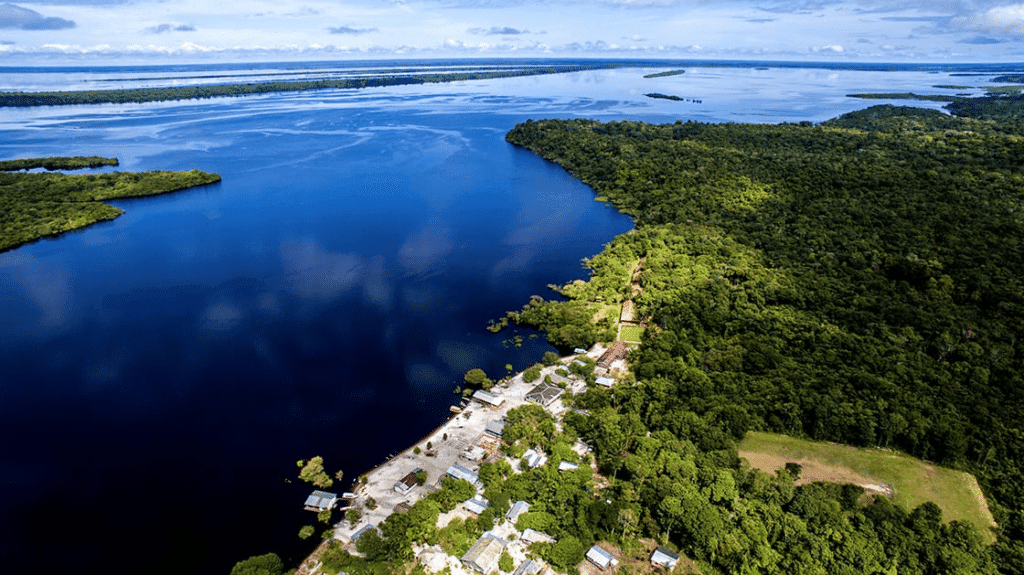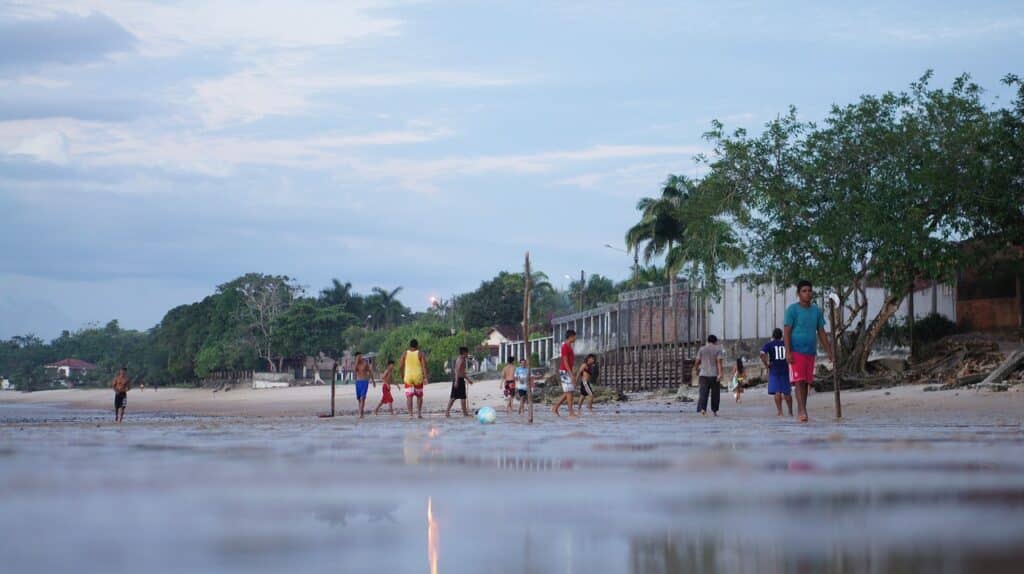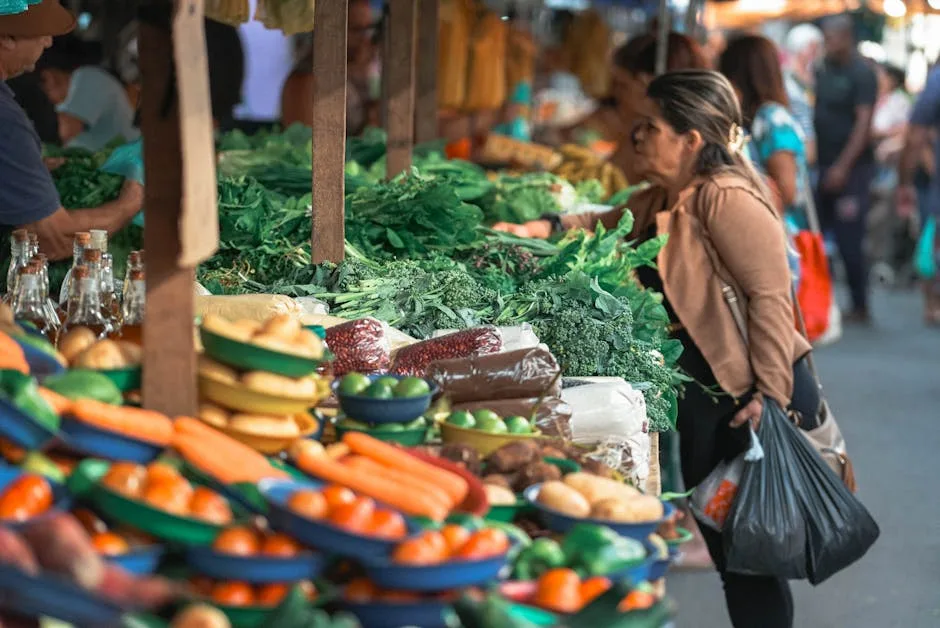Introduction to the Amazon Winter
The Amazon winter, typically spanning from December to May, is a distinctive season characterized by cooler temperatures and increased rainfall. This period, often misunderstood, reveals a unique side of the Amazon Rainforest that is both captivating and less traversed by the usual influx of tourists. During these months, average temperatures range from a mild 23°C to 28°C (73°F to 82°F), providing a refreshing contrast to the otherwise hot and humid climate experienced throughout the rest of the year.
The Amazon winter brings a substantial increase in rainfall, leading to the swelling of rivers and the transformation of the forest landscape. The abundant rain nourishes the vegetation, resulting in even lusher landscapes that offer a breathtaking spectacle of nature’s vibrancy. This season of renewal and growth is a perfect backdrop for exploring the diverse flora and fauna of the region, with the forest brimming with life.
One of the most compelling reasons to visit the Amazon during winter is the reduced number of tourists. The quieter trails and waterways afford a more intimate and immersive experience, allowing visitors to connect deeply with the natural environment. The tranquility of the season enhances the opportunity to observe unique wildlife behaviors, as many species become more active and visible. Birdwatchers, in particular, will find this season rewarding, with numerous migratory birds making their way to the Amazon.
In addition to the rich biodiversity, the cooler and wetter conditions of the Amazon winter create an ideal setting for various activities. From river cruises and guided jungle hikes to canoeing through flooded forests, the options for adventure are plentiful. Whether you are an avid nature enthusiast or a casual traveler, the Amazon winter promises a distinctive and unforgettable experience, showcasing the unparalleled beauty and complexity of one of the world’s most renowned ecosystems.
Weather Patterns and Climate During Amazon Winter
The Amazon winter, occurring from May to October, presents a unique climate that differs significantly from the well-known wet season. Average temperatures during this period typically range between 22°C (72°F) and 28°C (82°F). This cooler season offers a respite from the sweltering heat of the summer months, making it a more comfortable time for exploring the lush rainforests and vibrant ecosystems.
Humidity levels remain relatively high throughout the Amazon winter, though they are slightly lower compared to the wet season. Travelers can expect humidity to hover around 80%, which contributes to the dense and rich atmosphere of the rainforest. Despite the decrease, the air retains its characteristic dampness, enveloping visitors in the Amazon’s distinctive, tropical environment.
Rainfall during the Amazon winter is less intense than during the wet season, but it is still a prominent feature of the climate. Monthly rainfall averages between 150 to 200 millimeters, providing ample moisture to sustain the dense foliage and diverse wildlife. Rain showers are typically brief and often occur in the afternoon, allowing mornings and evenings to be relatively dry and ideal for outdoor activities.
These weather conditions significantly impact travel plans to the Amazon. The cooler temperatures and reduced rainfall make it a favorable time for trekking, river cruises, and wildlife spotting. However, travelers should still be prepared for the rainforest’s unpredictable weather. Packing essentials include lightweight, breathable clothing, waterproof gear, and sturdy, non-slip footwear. A good insect repellent is also advisable, as the humid environment remains a haven for mosquitoes.
In summary, the Amazon winter offers a comfortable and accessible time for visitors, with manageable temperatures and moderate rainfall enhancing the overall experience. Proper preparation and packing can ensure that travelers make the most of their Amazonian adventure during this cooler season.
Top Destinations in the Amazon During Winter
The Amazon Rainforest, a colossal expanse of biodiversity, offers distinct charm during the winter season, particularly between June and September. The cooler, drier months offer a unique perspective of this lush ecosystem. Here are some of the top destinations worth exploring during this season.
Manaus: Often referred to as the gateway to the Amazon, Manaus is a thriving city nestled in the heart of the rainforest. Visitors can explore the majestic Opera House, a remnant of the city’s rubber boom era, and indulge in local cuisine at the bustling markets. Additionally, winter is an ideal time for river cruises that showcase the Meeting of Waters, where the black Rio Negro and the sandy-colored Amazon River flow side by side without merging.
The Amazon River: The lifeblood of the rainforest, the Amazon River transforms during the cooler months. Water levels drop, exposing sandy riverbanks and allowing for intimate wildlife sightings. Activities such as piranha fishing, dolphin watching, and visiting indigenous communities become even more engaging and accessible.
Anavilhanas Archipelago: This sprawling network of over 400 islands is one of the largest river archipelagos in the world. During the winter season, the lower water levels reveal hidden beaches and intricate waterways perfect for canoeing. The region is a haven for bird watchers, with species like the vibrant macaws and toucans being particularly active.

Jaú National Park: As one of the largest national parks in Brazil, Jaú is a paradise for nature enthusiasts. The cooler, drier winter months provide excellent conditions for trekking and observing the myriad of flora and fauna. The park is home to unique species such as the Amazonian manatee and the giant otter, offering unforgettable wildlife encounters.
These destinations not only showcase the Amazon’s unparalleled biodiversity but also offer a range of activities and experiences that are particularly enjoyable during the winter season. Whether it’s exploring vibrant cities, navigating riverine landscapes, or immersing oneself in the tranquility of nature reserves, the Amazon in winter is an adventure waiting to be discovered.
Wildlife Spotting: Unique Species and Behaviors in Winter
Visiting the Amazon during the cooler months presents a remarkable opportunity for wildlife enthusiasts to observe a variety of unique species and behaviors that are more prominent in winter. This period, characterized by lower water levels and milder temperatures, is ideal for encountering some of the Amazon’s iconic inhabitants.
One of the standout species to look for is the jaguar. These elusive big cats are more likely to be seen during the Amazon winter as they tend to roam the riverbanks in search of prey. Early mornings and late afternoons are the best times for spotting jaguars, particularly in regions like the Pantanal, which is renowned for its high jaguar density.
The pink river dolphin, another fascinating creature of the Amazon, becomes more visible in the winter months. These dolphins navigate the shallower waters with ease, often coming closer to the riverbanks. Wildlife enthusiasts can witness their playful antics and distinctive pink hue, especially in areas like the Rio Negro and the Amazon River itself.
Birdwatchers will find the Amazon winter particularly rewarding. The cooler season attracts a plethora of bird species, including the vibrant macaws, toucans, and the elusive harpy eagle. The reduced foliage due to lower water levels makes it easier to spot and photograph these avian wonders. Key birdwatching spots include the Tambopata National Reserve and the Yasuni National Park, where guided tours can enhance the experience.
To maximize wildlife spotting, it is advisable to embark on guided tours led by experienced naturalists who can navigate the terrain and provide insights into animal behaviors. Early morning excursions and twilight safaris are particularly effective times for wildlife sightings. Additionally, staying in eco-lodges positioned within or near conservation areas can increase the chances of encountering diverse species in their natural habitats.
In essence, the Amazon winter unveils a rich tapestry of life and activity, offering unparalleled opportunities for wildlife enthusiasts to connect with nature’s marvels. By visiting during this season, travelers can witness the Amazon’s unique biodiversity in a more accessible and observable manner.
Cultural Experiences and Local Communities
The Amazon rainforest is not just a natural wonder but also a cultural treasure trove, inhabited by a multitude of indigenous communities with rich and diverse traditions. The cooler season offers a unique opportunity to engage deeply with these local communities, understanding their way of life and partaking in their traditional activities.
Many indigenous tribes in the Amazon are open to sharing their heritage with visitors, offering immersive experiences that are both educational and transformative. Visitors can participate in traditional ceremonies, learn about ancient medicinal practices, and even partake in communal meals featuring locally sourced ingredients. These interactions provide a rare glimpse into the lives of the Amazon’s original inhabitants, fostering a deeper appreciation for their culture and the rainforest itself.
Engaging with local communities is not just about observation but also about active participation. Visitors can take part in crafting sessions where they learn to make traditional items such as pottery, baskets, and textiles. These activities not only offer a hands-on understanding of indigenous craftsmanship but also support community economies by purchasing locally made goods.
The importance of responsible tourism cannot be overstated. Respecting local customs and traditions is paramount to ensuring that the cultural integrity of these communities is preserved. Visitors are encouraged to approach with a mindset of learning and respect, adhering to guidelines provided by community leaders. This includes seeking permission before taking photographs, dressing modestly, and showing respect during ceremonies and rituals.
Responsible tourism also involves contributing positively to the community. This can be achieved by choosing eco-friendly tour operators who prioritize sustainable practices, ensuring that the benefits of tourism are equitably distributed. By doing so, visitors help in the preservation of both the cultural and natural heritage of the Amazon.
In essence, the Amazon offers a rich tapestry of cultural experiences that are as enlightening as they are enjoyable. Engaging with local communities during the cooler season not only provides a deeper connection to the region but also plays a crucial role in promoting and preserving the vibrant cultures that call the Amazon home.
Adventure Activities and Eco-Tourism
During the Amazon winter, adventure enthusiasts are presented with an array of exhilarating activities that capitalize on the region’s unique ecosystem. Jungle trekking emerges as a quintessential experience, allowing explorers to traverse dense rainforests teeming with biodiversity. On these treks, visitors can expect to encounter a myriad of wildlife, from colorful birds and playful monkeys to elusive jaguars and vibrant plant species. It is essential to embark on these journeys with experienced guides who can navigate the terrain and ensure the safety of all participants while providing insightful information about the flora and fauna.
Another popular activity is river cruising along the mighty Amazon River and its tributaries. These cruises offer a serene yet immersive way to experience the natural beauty of the region. Passengers can enjoy panoramic views from the comfort of a boat, spotting dolphins, caimans, and an array of aquatic birds along the way. For those interested in a more intimate encounter with the river’s ecosystem, smaller canoe tours are also available, allowing for closer interaction with the water and its inhabitants. Safety precautions, such as wearing life vests and following the guide’s instructions, are paramount to ensure a safe and enjoyable experience.
Canopy tours provide a thrilling perspective of the Amazon rainforest from above. Utilizing zip lines and suspended bridges, adventurers can navigate the forest canopy, gaining a bird’s-eye view of the lush landscape below. This activity not only offers an adrenaline rush but also a unique opportunity to observe species that dwell in the upper layers of the rainforest. It’s important to choose reputable tour operators who adhere to safety standards and have well-maintained equipment.
Eco-tourism and sustainable travel practices are integral to preserving the Amazon’s delicate environment. Tourists are encouraged to select eco-friendly operators who prioritize environmental conservation and support local communities. By doing so, visitors contribute to the protection of this vital ecosystem while fostering economic benefits for indigenous populations. Sustainable travel practices, such as minimizing waste and respecting wildlife, help ensure that the Amazon can be enjoyed by future generations.
Accommodation Options: From Luxury Lodges to Eco-Friendly Stays
Exploring the Amazon during the cooler season provides an opportunity to experience the region in optimal conditions, and choosing the right accommodation can significantly enhance this experience. For those seeking a touch of luxury amidst the wilderness, there are several high-end lodges that offer an unparalleled blend of comfort and adventure. These luxury lodges are equipped with modern amenities, including gourmet dining, spa services, and guided excursions, ensuring that travelers enjoy the best of both worlds—exquisite comfort and the raw beauty of the Amazon rainforest.
One notable example is the Anavilhanas Jungle Lodge, located in the heart of the Amazon. This lodge provides a range of opulent bungalows and cottages that offer stunning views of the Rio Negro. Guests can indulge in activities such as boat tours, wildlife spotting, and cultural visits to local communities, all while enjoying the plush comforts of their accommodation. Similarly, the Cristalino Jungle Lodge in the southern Amazon is renowned for its luxurious yet environmentally conscious design, blending seamlessly with its natural surroundings and offering a unique experience of the rainforest’s biodiversity.
For eco-conscious travelers, the Amazon boasts a variety of eco-friendly accommodations that prioritize sustainability and minimize environmental impact. These eco-lodges are designed to harmonize with the natural environment and often utilize renewable energy sources, waste reduction practices, and locally sourced materials. The Juma Amazon Lodge stands out as an exemplary eco-friendly stay, built on stilts over the Juma River, ensuring minimal disruption to the ecosystem. Here, guests can participate in eco-tours, learn about conservation efforts, and immerse themselves in the serene beauty of the Amazon.
Another excellent option is the Uakari Floating Lodge, situated within the Mamirauá Sustainable Development Reserve. This lodge not only offers comfortable accommodations but also supports significant research and conservation projects. Guests staying at Uakari can enjoy guided wildlife tours, bird watching, and an authentic Amazonian experience, all while contributing to the preservation of this unique environment.
Whether opting for luxury or sustainability, travelers to the Amazon during the cooler season will find a range of accommodation options that cater to diverse preferences and ensure a memorable stay in one of the world’s most extraordinary natural landscapes.
Tips for Planning Your Amazon Winter Trip
When planning a trip to the Amazon during the winter season, it is essential to consider several practical aspects to ensure a smooth and enjoyable experience. The Amazon winter, typically spanning from June to September, is characterized by milder temperatures and decreased rainfall, making it an ideal time for exploration.
Firstly, determining the best time to visit is crucial. The Amazon basin experiences its cooler and drier period during winter, offering more manageable weather conditions for travelers. This season is generally considered the best time for wildlife spotting and exploring the diverse flora and fauna of the region.
Accessing the Amazon can be achieved through various means. Major entry points include airports in Manaus, Brazil, and Iquitos, Peru. From these cities, travelers can take riverboats or small aircraft to reach more remote areas. Booking transportation in advance is advisable, particularly during peak tourist seasons.
Packing appropriately is vital for a comfortable journey. Essential items include lightweight, breathable clothing, a sturdy pair of hiking boots, a wide-brimmed hat, and a high-SPF sunscreen. Additionally, packing a reliable insect repellent is crucial to protect against mosquitoes, which can be prevalent even during the cooler months.
Health precautions should not be overlooked. Travelers are advised to consult their healthcare provider regarding necessary vaccinations, such as Yellow Fever and Typhoid. Carrying a basic first-aid kit, including anti-malarial medication, can provide added security. It is also beneficial to have comprehensive travel insurance covering medical emergencies and evacuation, if necessary.
Lastly, having a list of emergency contacts is a prudent measure. This should include local embassy or consulate information, local emergency services, and contact details for your travel insurance provider. Being prepared with this information ensures peace of mind throughout your Amazon adventure.





